Long COVID: ‘Will We Get Better?’
Long COVID is an unwelcome guest that may steal your energy, sleep, ability to work or take care of family responsibilities, sense of well-being — even your life. Three doctors and a panel of people with long COVID symptoms came together to explore what’s on the horizon for patients

As a society — indeed, around the world — we are settling into the notion that COVID-19 is now endemic, with new variants of concern (and new vaccines) emerging periodically. For some, though, COVID isn’t just a momentary acute illness or a minor inconvenience.
Long COVID is defined by the World Health Organization as the continuation of symptoms or development of new symptoms for three months after the initial SARS-CoV-2 infection, with symptoms lasting for at least two months with no other explanation. It has played a role in more than 3,500 deaths in the US, according to the Centers for Disease Control and Prevention (CDC), which recently performed an analysis of death certificates. Nearly one in five adults who have had COVID-19 continue to suffer from symptoms of long COVID after acute infection.
Emory Medicine magazine asked three Emory experts who specialize in long COVID to host a virtual Dinner with a Doctor with several panelists who have the condition.
Our doctors are: Igho Ofotokun, Grady Distinguished Professor of Medicine at Emory School of Medicine, fellow of the Infectious Diseases Society of America, and member of the National Academy of Medicine; Alex Truong, assistant professor of pulmonary and critical care and one of the co-directors of Emory’s post-COVID clinic; and Tiffany Walker, assistant professor of general internal medicine at Emory and clinician at Grady’s long COVID clinic.
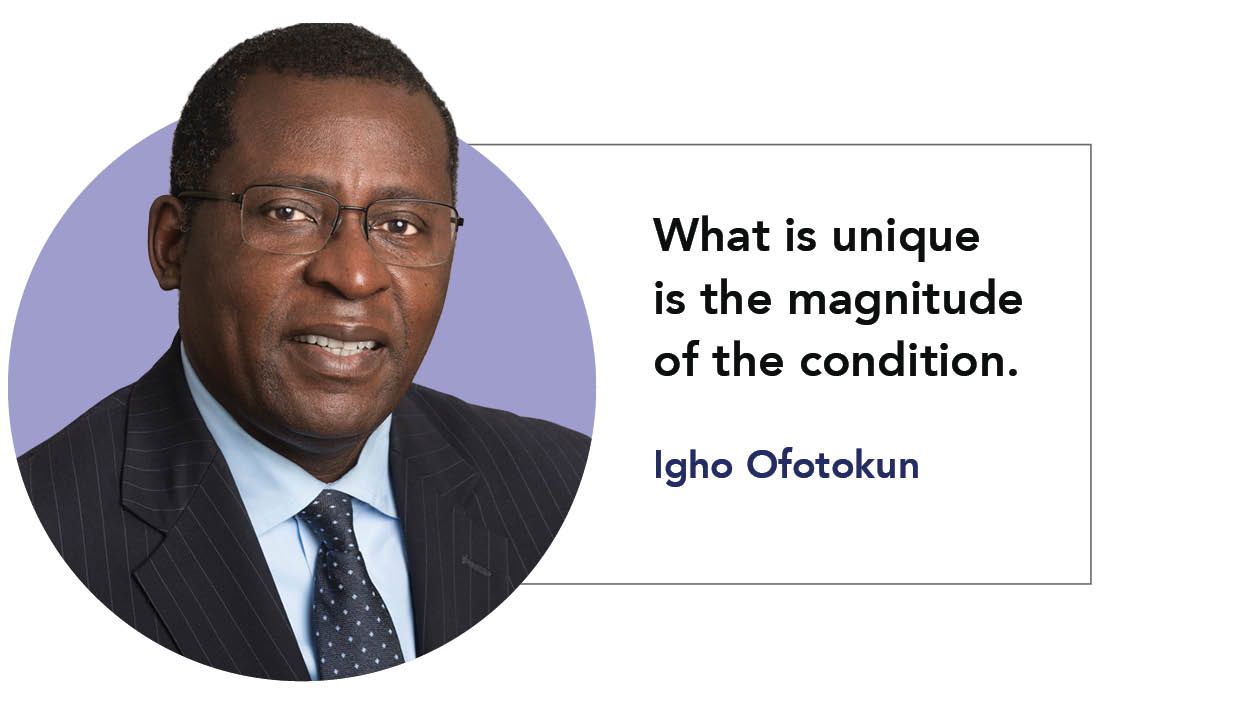
All three clinician-researchers are involved in the National Institutes of Health (NIH) study Researching COVID to Enhance Recovery (RECOVER), which is “aimed at understanding the long-term post-acute sequelae of COVID-19,” says Ofotokun, who leads the Atlanta hub of the NIH initiative and is the national chair of the RECOVER Adult Cohort Coordinating Committee.
Our panelists are: Claire Tyrpak, 63, a retired American who lives in Merida, Mexico, and who was diagnosed with long COVID last year, with heart palpitations and other neurological symptoms after her second COVID infection; Jill Camper, 37, who works in student affairs in higher education, has had long COVID for about two years; Zoe Newmarco, 27, a doula who lives in rural Vermont and who experienced long COVID after her second infection, with symptoms including brain fog, short-term memory loss, and fatigue; and Silvana Knight, 61, a Realtor from Lakeland, Florida, who recently recovered from her fourth bout of COVID and has long COVID symptoms including phantom smells and migraines.
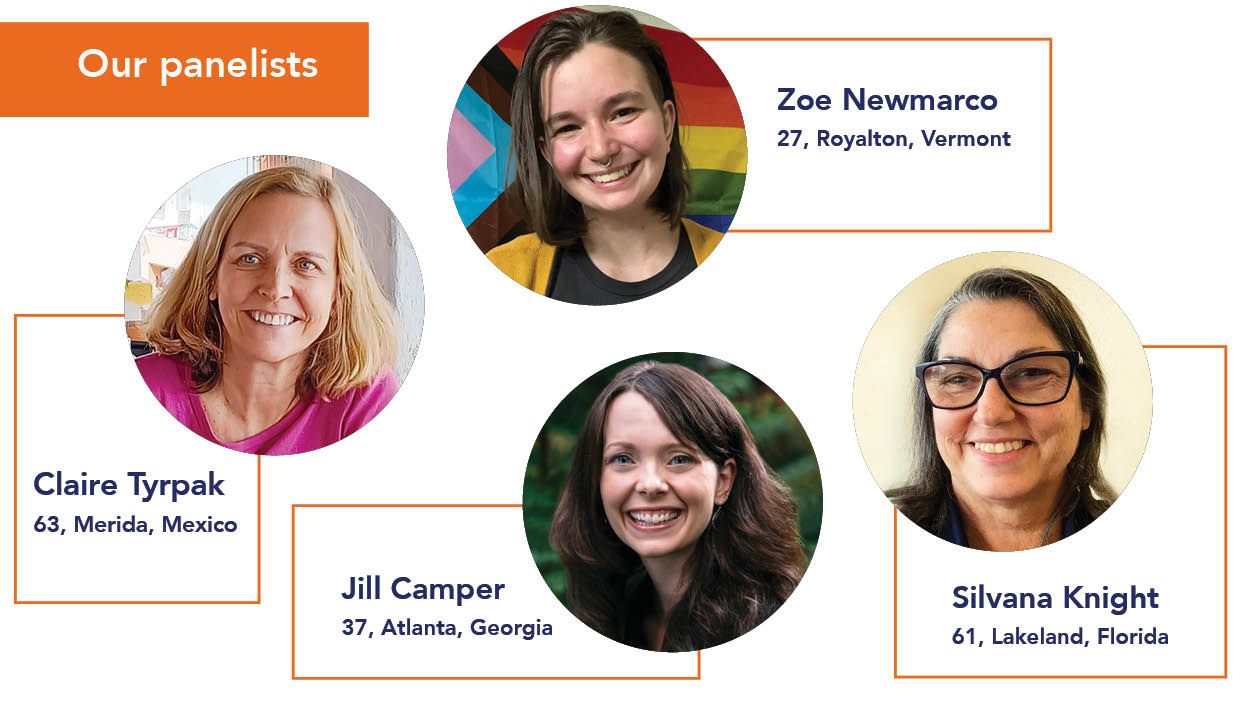
A complex constellation of symptoms constitutes long COVID, which affects nearly every organ system.
Some of the most debilitating symptoms include breathing problems, heart issues, extreme fatigue, migraines, and cognitive and neurological issues. Specific symptoms include brain fog, “internal trembling,” insomnia, abdominal pain, heart palpitations, diarrhea, fevers, lightheadedness, blood clots, joint pain, and on and on.
“It seems there might be different types of long COVID, not just one unified diagnosis, more like an umbrella diagnosis with different flavors to describe it and different underlying mechanisms driving it,” says Walker. “We’re at the tip of the iceberg right now in our understanding of long COVID, but the studies we’re doing will be helpful in getting a better understanding of the condition and finding potential treatments.”
Women are significantly more likely than men to experience long COVID. Patients over 40 with previous health issues or who did not get a COVID-19 vaccine also are more likely to develop the condition. Those who had severe coronavirus infections have a greater risk of developing long COVID, although “we’ve seen a lot of people with really mild COVID going on to have pretty severe long COVID,” Walker says.
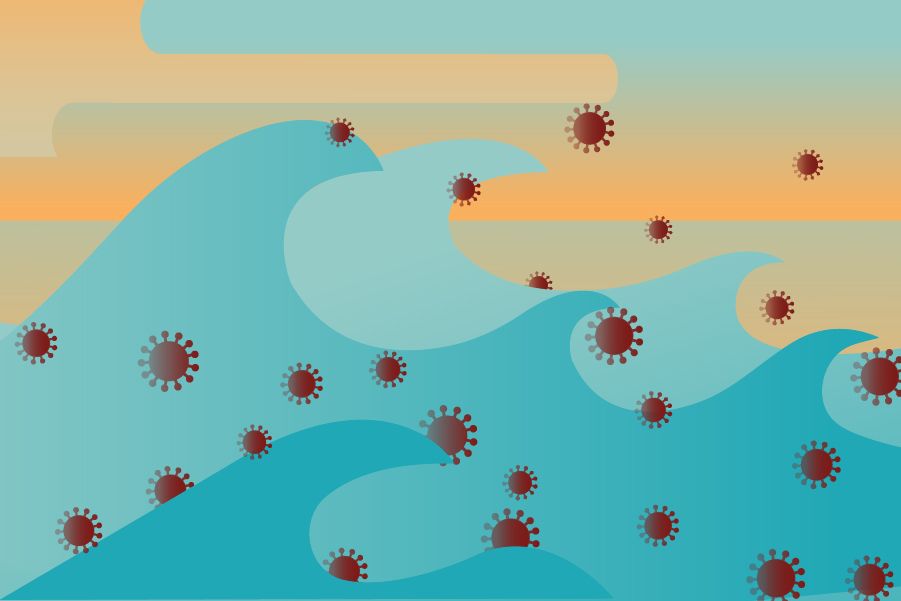
“The state of long COVID is evolving and in flux,” says Truong. “There are a lot of theories. Is it driven by inflammation, autoimmunity, mast cell activation syndrome? Because we lack a unifying pathology that explains all the issues, at this point, we are stuck treating each of the components of the syndrome as if they are different diseases.”
This can cause confusion in patients and may result in them bouncing from specialist to specialist without any clinician addressing the larger issue.
A Look at the RECOVER Initiative
The National Institutes of Health (NIH) created the Researching COVID to Enhance Recovery (RECOVER) initiative to learn about the long-term effects of COVID. The goal of RECOVER is to rapidly improve our understanding of and ability to predict, treat, and prevent post-acute sequelae of SARS-CoV-2, including long COVID.
Ofotokun says, “We have more than 14,000 adults and about 12,000 pediatric patients already and are aiming for around 40,000 people from all over the country. Once we understand the drivers, we’ll be able to come up with targeted interventions.”
RECOVER is the largest study ever of its type; Congress gave the NIH $1.2 billion funding for the initiative. There are five different cohorts: adult, pediatric, pregnancy, autopsy, and e-health records.
“The study is very comprehensive,” he adds. “It will be the largest database for any medical condition in the history of humankind. Our hope is that we can, at the least, provide the empiric evidence that long COVID is real, this is how people present who have it, and this is what it does to the body. Ideally, it will also tell us what we can do to prevent and treat it.”

Indeed, the panelists each have experienced a version of this confusion, which led to feelings of frustration and despair.
“All my symptoms have been neurological; it felt like my nervous system was out of whack,” says one. “It started with heart palpitations, tingling and heat in different parts of my body, then my limbs felt very heavy and weak. There was some anxiety and insomnia. More recently it's been mast cell activation syndrome, where my body reacts allergically to many foods.”
“Our understanding of this condition is evolving,” says Ofotokun. “As I am an infectious disease doctor, this phenomenon is not completely new to me. We do know that when people suffer from viral infections, many recover without any lingering effect. But a small proportion progress to develop a post-effect of this acute infection. We see this in flu as well as other types of viruses.”
For example, enteroviruses can cause viral cardiomyopathy, and flaviviruses like West Nile can cause a Parkinson’s-like disease that affects the brain.
“We know from other viruses that there are two possibilities: after acute infection, some people may not completely clear the virus—small amounts remain in pockets of the body and can be responsible for some of these long-lasting symptoms,” Ofotokun continues. “Also, these small pockets of virus can trigger the immune system so it is continuously activated, which can lead to organ damage and symptoms like brain fog, blood clots, inflammation of small blood vessels, or autoimmune diseases.”
“So this is not new,” he says of long COVID. “What is unique is the magnitude of the condition.”
Discovering the drivers of long COVID will be the first step toward finding therapeutics or even a cure. “We have speculation,” Ofotokun says. “The first, as we’ve said, is that the body is not able to completely clear the virus, and wherever the virus has gone to in the body, that’s where the symptoms are. Another possibility: the virus might have caused irreparable damage during the acute stage, even to organs.”
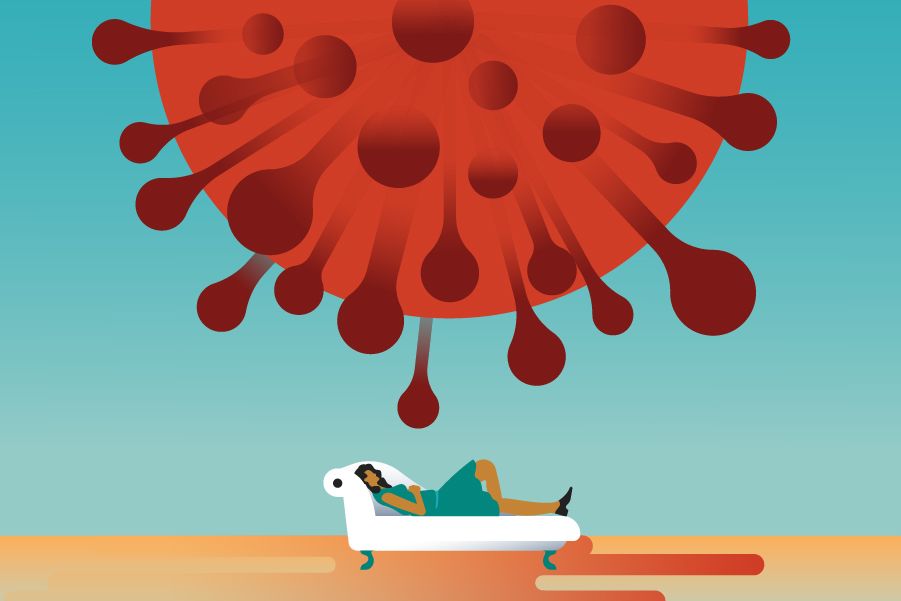
Another panelist shared that the last time she had COVID, she noticed that “my headaches have been massive. Not migraine-like, but intense pressure. That is a telltale sign for me. Each and every time I get COVID, my headaches get progressively worse,” she says. “I also lost my taste and smell for a month at the beginning of Delta. I’ve had phantom smells going on now for about two years. It smells like I’m in a cigarette factory at any given moment. It’s just weird. Is the long-term effect in my nasal cavity, lungs, or brain?”
Phantosmia, an olfactory sensation that occurs when there is no odor source, is a symptom of COVID and long COVID.
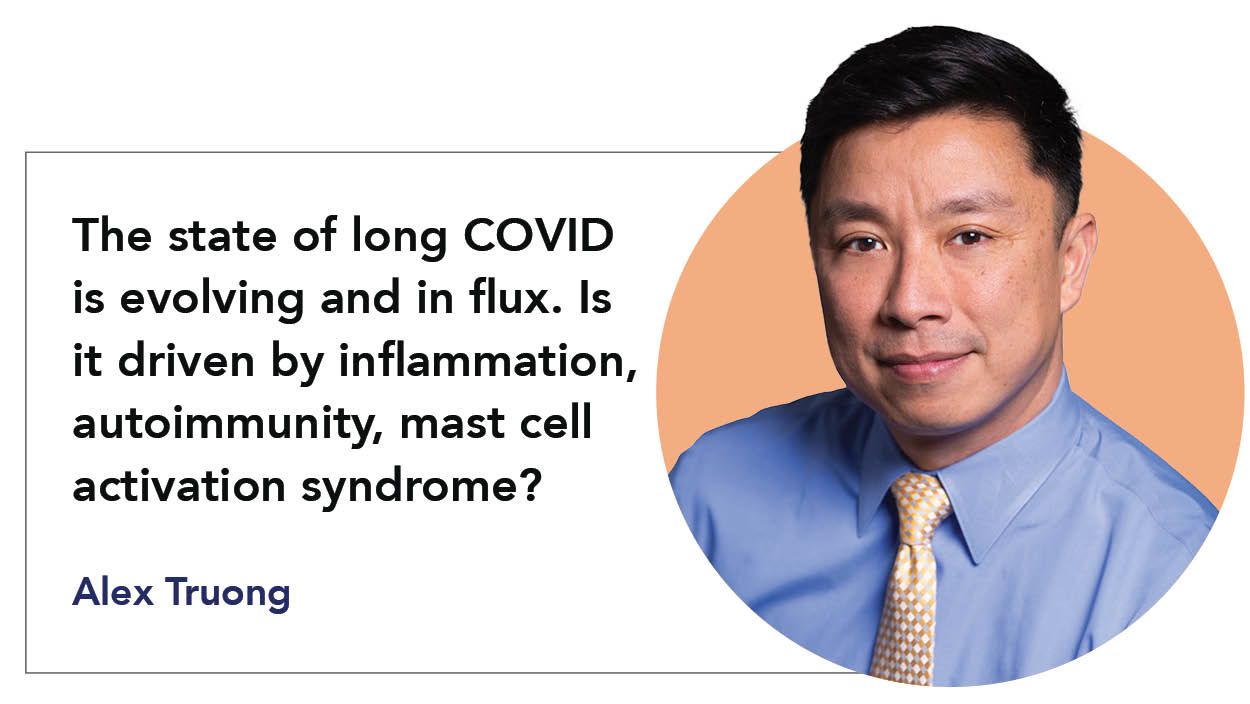
“Our understanding is that changes in smell in patients is driven by their nerves,” says Truong. “We’ve had a bit of success with smell retraining, which can be done through speech therapy. But overall, the changes in smell are challenging, there doesn’t seem to be a good understanding of why it’s happening.”
As far as the headaches, Truong says, pain syndrome — whether headaches or muscle and joint pains — is common in long-COVID patients, just behind brain fog and fatigue.
“It seems to be a hypersensitivity of the nerve endings,” he says. “Either patients develop pain syndrome or the pain syndrome a patient had previous to long COVID gets a lot worse. Treating that has been challenging. I’ve stayed away from treating with opiates but use medications like gabapentin and pregabalin, which help numb some of those nerve endings. Unfortunately, the side effect of that is sedation, so my fatigue patients are really trading one devil for another.”
“My symptoms go away as quickly as they come,” the panelist continues, “so I’m thankful for that. But every time something happens, you think, is this long COVID or something completely different?”
“One characteristic we see of long COVID is it really waxes and wanes,” says Walker. “You may have headaches for 10 days straight and then 20 days without them. When they go away, you think, Yea, my headaches are gone,’ but then they come back, so it makes you nervous that something new is happening or it’s getting worse. But that seems to be the natural course of symptoms in long COVID.”
The panelists shared a common concern: Will they get better?
“Yes, you will probably get better whether we find a cure or not,” says Truong. “A lot of patients who come through our clinic, we throw the kitchen sink at them, and some treatments work, some don’t, some have negative side effects, but there is a large population who do get better and graduate from our clinic.”
And treatments are bound to get better with the amount of research going on around COVID and long COVID, the doctors agree.
“Whether it’s trying Paxlovid or other medicines, or extrapolating from different disease processes, we are finding out what works and what doesn’t,” Truong says. “I’ve been doing our clinic for a while now and I will say, we have been super successful at finding things that do NOT work. But there have been things that do work and make patients feel better. Part of that has to do with the fact that often patients feel defeated and isolated and have been told by a lot of folks this illness may not be real, or they just need to get over it. With the right clinic and the right set of professionals trying different things, patients do get better. So don’t lose hope.”
One panelist, who found such help at Emory’s long-COVID clinic with Truong leading her care, says a symptom she is still struggling with is an imbalance of acid production. “It doesn’t give me heartburn but actually affects my breathing,” she says. “Most of my symptoms have gone away, but that’s the lingering one. I’ve read a lot about gastro issues being common in long COVID patients. When I eat, I can’t breathe. Are there any breakthroughs in the gastro department?”
“Some of us, as providers, didn’t see many gastro patients in the beginning. So it was not really on our radar,” says Walker. “But we see a lot more about it now, both in patients and in the scientific literature: IBS, constipation, diarrhea, cramping pains, gastroparesis, all related to long COVID.”
”Often patients feel defeated and isolated and have been told by a lot of folks that [long COVID] may not be real, or they just need to ‘get over it.’ With the right clinic and the right set of professionals trying different things, patients do get better.
So don’t lose hope.”

Ofotokun adds: “The RECOVER study is looking at almost every bodily system, including the GI system, to examine these kinds of symptoms. I’m hoping we will have many stories like yours to help us understand how long COVID affects the GI tract, brain, bone, and heart. The stories of thousands come together to form a critical mass and then we can see the patterns.”
Another panelist, who has several family members who also have long-COVID symptoms, says she is curious about lasting damage due to COVID: Could the virus turn into something else later?
Indeed, there are times when people have infections and, many years later, develop a different illness as a result, says Ofotokun.
“Perhaps it becomes a trigger for diabetes, heart failure, cancer. Those are some of the things that really worry us. Changes in your immune system, in your genetic profile, may become something bad down the road,” he says. “For some, even when the virus goes away, it damages their immune system—turns it upside down so it doesn’t act normal anymore. That change can lead to autoimmune diseases: lupus, rheumatoid arthritis, Sjogren’s syndrome. We see this phenomenon with other viruses as well.”
So why are some people completely able to clear the COVID-19 virus while others are not? Does it matter how severe your acute COVID infection was?
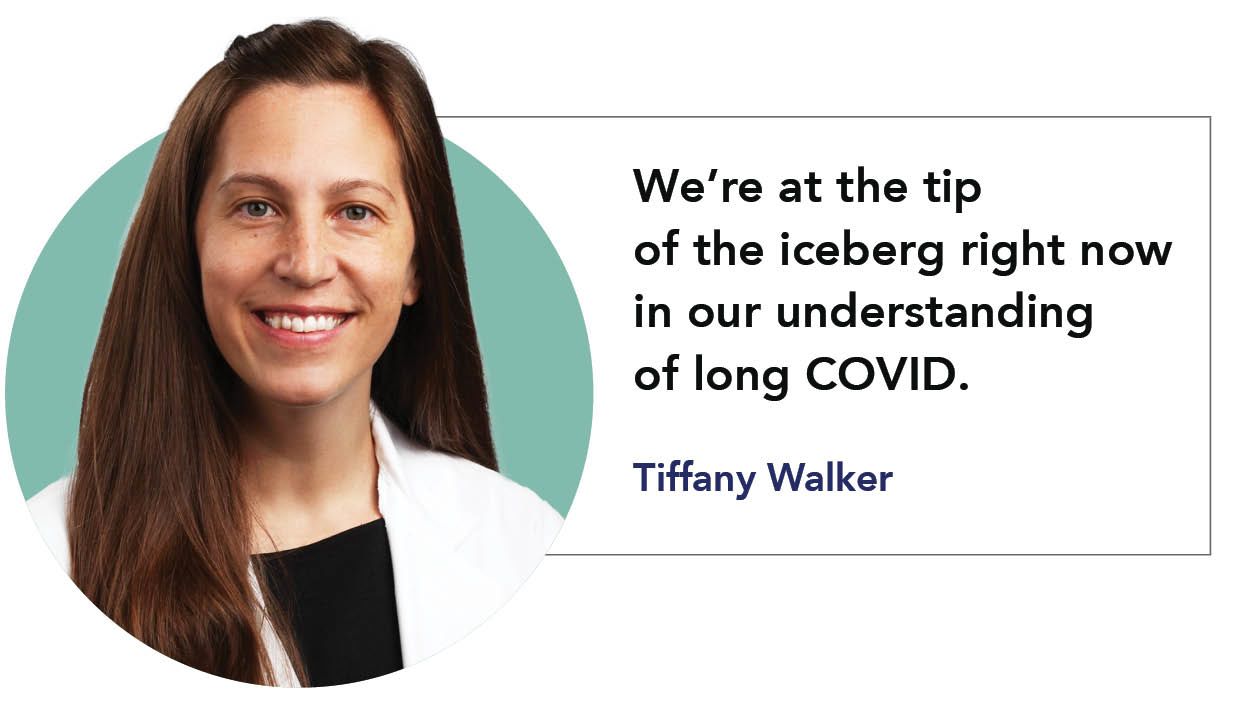
“We’re still in the stage of trying to figure out if there’s a correlation between how you initially present and how lingering your symptoms are,” says Truong. “Literature seems to argue that the more severe COVID illness you have initially, the more likely you will have post-COVID or long-COVID issues. But the vast majority of patients we are seeing, probably 90 to 95 percent, are patients who had very mild symptoms with their initial infection, never had hospitalization or required advanced care, yet have had significant lingering symptoms.”
Symptoms so severe, he adds, that “the rates of long-COVID patients losing jobs or being forced to retire early are exceedingly high because they can’t function.”
A panelist agreed, saying, “Long COVID is the weirdest thing I’ve been through in my entire life, and I’ve had cancer. The gamut of symptoms, it’s terrifying.”
Another panelist asks: What is on the horizon, as far as long-COVID research results?
In the RECOVER study, says Ofotokun, in addition to physical testing, there will be multiomic testing to see if there are changes now that relate to later developments. “If we do it well, the lessons from long COVID may also be able to help us treat the postacute illnesses of other infections,” he says.
An important focus of the RECOVER study will be delving beyond baseline symptoms to the underlying mechanisms. Certain symptoms in study volunteers may trigger additional testing and imaging, such as CT scans of the lungs or pulmonary-function tests. At an even higher level, there could be more invasive testing, such as muscle biopsies, MRIs, and lumbar punctures, which will provide more information about long-term damage at a systemic level. Researchers also are collecting blood for a biorepository.
“We can use the results to see if there is other end-organ damage occurring related to people’s immune responses,” Walker says. “It’s a very comprehensive study. And to do it, we need the help of people who have long COVID: to recruit, enroll, have in for visits, then run studies. It’s a long road, which is true of most studies, but this one was erected much faster than any study like this has ever been, with an unprecedented rate of getting patients into the study. It will be a real beacon of hope once we get that information out.”
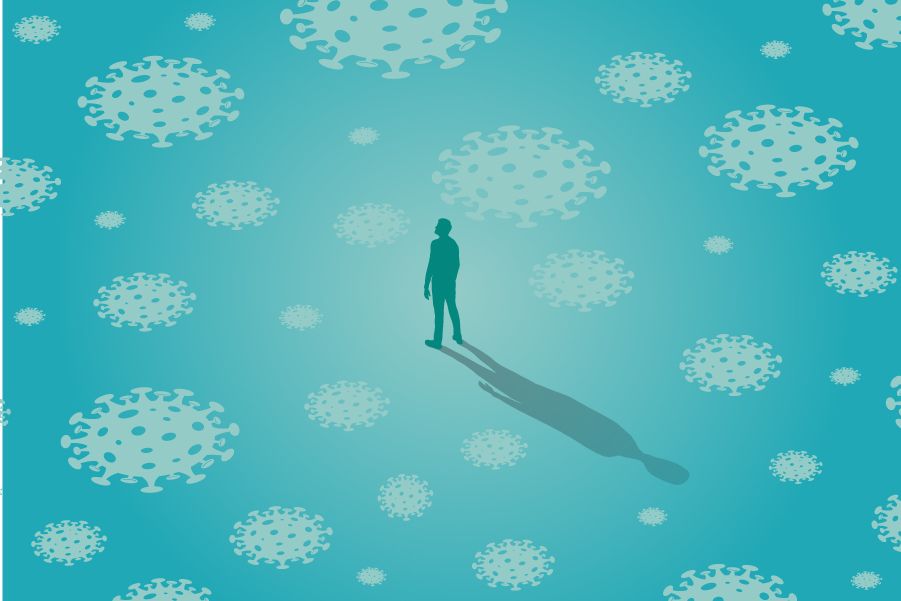
Another panelist asks: What factors help prevent someone from getting long COVID?
“That’s an easy one. Not getting COVID or not getting reinfected with COVID,” says Truong. “There is definitely COVID fatigue, I feel it, I understand it very well. But appropriate masking, getting vaccinations, choosing which large events you’re going to join are all still important. I often see that my patients who get infected again have an upsurge in their symptoms that tends to last a while.”
Ofotokun adds: “One of the things that prevents severe infection is vaccination. It doesn’t eliminate the risk, but it does reduce it. Secondly, we are finding from studies that with subsequent episodes of long COVID, your risk of long COVID increases. Third, when you get the acute infection, you should be treated with Paxlovid. This reduces the severity, if you are treated with an antiviral agent during acute infection.”
“I’ve found oftentimes it’s the younger population that is least concerned about COVID,” says Walker. “But patients in their 20s, 30s, and 40s, while they have a lower risk of severe outcomes from acute COVID, have higher rates of dysautonomia, a disorder of the autonomic nervous system where, when you stand up, you get dizzy, your heart races, you get a headache, and you feel awful. It’s one of the most disabling forms of long COVID. We’ve seen it in patients quite young and three years later, it’s not much better. So that’s a real concern.”
What should we do now, ask the panelists. Do we just wait? Are there actions we can take?
“A couple of different options are coming out in terms of clinical trials,” says Walker. “You can check out the website clinicaltrials.gov to see what trials are being done in long COVID and what you might qualify for.” Currently there are trials examining the benefits of Paxlovid and low-dose naltrexone, she says, among others.
Truong says he has seen patients, family, and friends respond well to an antihistamine regimen: “You’ll know in about two to four weeks if it’s working. It helps address fatigue, brain fog, and shortness of breath. I’ve seen it reduce lingering symptoms.” Also, he says, aggressive hydration seems to help. “Brain fog gets worse if you’re dehydrated or sleep deprived. One side effect of long COVID is sleep disturbances.” Also, a bit of exercise on a regular basis helps, whether it’s walking around the block or at the grocery store. “It doesn’t have to be the gym, it doesn’t have to be intensive,” he says. “If you focus on endurance as opposed to weight bearing or strength building, it can help improve fatigue.”
“You are the best experts of long COVID,” says Ofotokun to the panelists. “There is no textbook on it. It’s the shared experience of all of you. Insist on talking about it, telling your story, reaching out to everyone who will listen including policymakers. That will help generate the momentum and resources we need to succeed. Don’t give up.”
Originally appeared in the Spring 2024 print edition of Emory Medicine Magazine.
Story by Mary Loftus. Illustrations by Shaw Nielsen and Getty Images. Design by Elizabeth Hautau Karp.

Want to know more?
Please visit Emory Magazine, Emory News Center, and Emory University.

